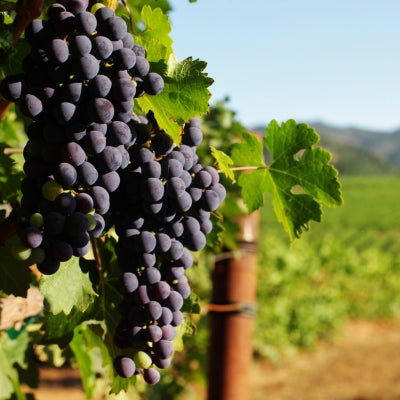
Grape School: Cabernet Sauvignon in the Old World
Last week we talked about the basics of Cabernet Sauvignon--where it thrives, what it tastes like, and how to pair it. This week we will talk about where you will find it in the Old World—in other words, Europe. We’ll discuss where it is made and who the renowned producers are in two key countries: France and Italy.
BORDEAUX
Bordeaux, a region in France, is likely where the best-known Cabernet Sauvignon-based wines come from. The climate in Bordeaux is moderate maritime with the Gulf Stream warming up the Atlantic. Proximity to a large body of water moderates the temperature on land, as large bodies of water can retain heat and release it over longer periods of time, making seasonal temperature shifts less extreme.
Bordeaux is located on the Gironde Estuary, which divides into two rivers: the Dordogne to the north, and the Garonne to the South. The land to the west of the Gironde and Garonne is what is known as the Left Bank of Bordeaux, and this is where the most Cabernet Sauvignon is grown. The soils of the Left Bank are critical to why Cabernet thrives here, and not so much on the Right Bank, the area to the east. The land between the Dordogne and the Garonne is known as Entre Deux Mers, incidentally, but if you see a wine labeled as such it will be a white wine made of Sauvignon Blanc and Semillon.
But what of those Left Bank soils? The gravel is the key to good drainage and adequate heat. As we discussed last week, Cabernet Sauvignon ripens late, so climates that cool down earlier in the season can make for “greener” wines if there is not enough heat to ripen the grape. But the stones of gravel are able to retain and radiate heat, keeping Cabernet warm enough to ripen fully.
Still, in Bordeaux Left Bank wines, you will most likely not be drinking 100% Cabernet Sauvignon. Merlot, Cabernet Franc, Petit Verdot, and Malbec may also be in the mix, adding finesse, spice, and in some cases filling in if not enough Cabernet Sauvignon has not fully ripened in a particular year.
There are many classifications of Bordeaux wines, but for the purposes of those who seek out premium wine, we will focus on those that achieved fame in the 1855 Classification. The chateaux were classified according to what they sold for with the top wines being the Premier Cru Classé chateaux, or the First Growths, the next tier being the Second Growths, and so on down to Fifth Growths.
There are five First Growths. Three are found in the appellation of Pauillac, where there is particularly deep gravel, and great proximity to the river. Chateau Latour, Chateau Lafite Rothschild and Chateau Mouton Rothschild are all found here, albeit Mouton was not elevated to First Growth status until 1973.
Further south, in the appellation of Margaux is where Chateau Margaux is found. There are more limestone and sand in Margaux, resulting in wines that, while still powerful, are of a more elegantly silky nature. Famed Third Growth Chateau Palmer is also found in Margaux, and, these days are often esteemed to be as great as the First Growths.
Further south, in Pessac-Leognan, is the First Growth Chateau Haut-Brion, which is the only First Growth found in Graves. The area features both sandy and gravel soils. Mission Haut-Brion is another prized wine found in the area.
TUSCANY
And now…Super Tuscans! As in Bordeaux, they are probably blends, albeit the Italian variety of Sangiovese may be part of the mix. How did the famed wines—we are talking the likes of Sassicaia and Ornellaia—come about? Well, it all began in Bolgheri, an area lying by the Ligurian sea, which moderates the warm Mediterranean climate. The soils are gravelly, much like Bordeaux.
In the 1940s, yearning for the wines of Bordeaux, Marchesi Mario Incisa della Rocchetta decided to plant Cabernet Franc, perhaps noting that the soils of Bolgheri were similar to Bordeaux. His intention was to keep the wine for home use but his nephew Piero Antinori took note of the wines and advised adding Cabernet Sauvignon to the mix.
Sassicaia, as the wine came to be known, was first released for the public to buy in 1971. However, because the wines included so varieties not native to Italy, the wines could not be sold as DOC wines. Still, the wines were fine and their reputation and popularity grew. Soon, Ornellaia and Solaia, along with a host of other “Super Tuscans” came to be known were selling for as much is not more than the DOC wines of the region. In 1994 Bolgheri became DOC that allows for a maximum of 70% Sangiovese, and Bolgheri Sassicaia became it’s own DOC later.
Not all the Super Tuscans are based on Cabernet Sauvignon. For instance, Tignanello is based on Sangiovese and Masseto is made of Merlot. However, Olmaia, Ornellaia, Sassicaia and Solaia are some of the top Cabernet Sauvignon based Super Tuscans, well worth seeking out.
Next week we will look to some of the most famous producers of Cabernet Sauvignon wines in the New World!
Photo @lairideok



